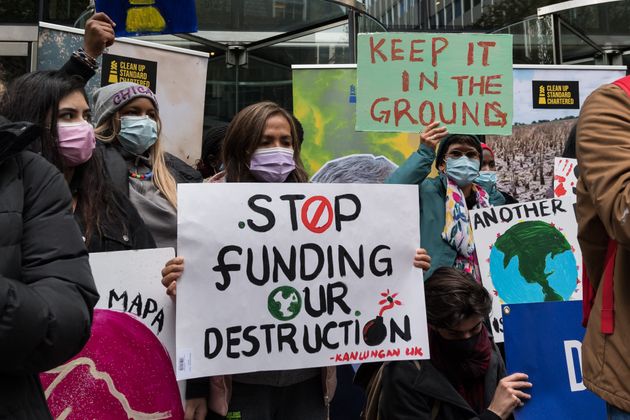Glasgow Could Set A Course Away From Climate Calamity — Or Cement A Disaster
[ad_1]
WAHYUDI via Getty Images
In December 2015, negotiators struck a deal in the French capital that had eluded the world for more than two decades. The Paris Agreement became the first global pact with the United States and China ― the world’s two great carbon superpowers ― to recognize the threat emissions pose to life on Earth and pledge to stop the damage.
Then chaos broke out.Exactly a year later, the United States, the world’s biggest cumulative source of emissions, elected a fossil fuel diehard in Donald Trumpwho quickly made his country the only one to withdraw from the accord. Jair Bolsonaro forged a similar path upon his election in Brazil,steward of the world’s largest rainforest, ramping up deforestation at a clip that tilted the scales for the first time toward more carbon-spewing in the Amazon than its canopy of leaves could absorb. China, the world’s largest annual emitter, initially canceled coal plants in droves, only to resume construction after a few years.
The latest review of the most up-to-date and trusted research available by the U.N.’s Intergovernmental Panel on Climate Change, the world’s premier climate science body, led the U.N. secretary-general to warn that we have reached “code red for humanity” as carbon, methane and other heat-trapping gases so thicken in the atmosphere that the changes to our planet’s ecosystems are on the brink of becoming irreversible.
And now the world will convene again, in Glasgow, Scotland, to confront this existential emergency.
The U.S. has rejoined the Paris Agreement and, with the potential passage of the Build Back Better legislation as soon as next week, could set the stage for a clean-energy spending blitz. But America’s powerful fossil fuel industry has successfully torpedoed even modest policies put forward to wean the country off gas and oil, and just last week, the conservative majority on the Supreme Court agreed to consider limiting the federal government’s power to regulate greenhouse gases.
India, now No. 3 in global emissions, has made huge investments in renewable energy but has balked at demands to do more to eliminate pollution. China, meanwhile, has closed its purse to overseas coal projects, only to ramp up production at home amid a global energy crunch.
Thiswas always set to be the most important climate summit since that fateful meeting in 2015. Anticipating the pact as a turning point in national energy policies, the Paris Agreement stipulated that, after five years, the negotiators would gather at the annual United Nations-run conference to reassess and strengthen the carbon-cutting targets. (In a sign of how interconnected and fragile the global system has become, the worst pandemic in over a century delayed the confab by a year.)
Anadolu Agency via Getty Images
The Paris Agreement set a goal of keeping global temperatures from exceeding 2 degrees Celsius, or 3.6 degrees Fahrenheit, above pre-industrial averages. A Glasgow pact was supposed to get the world over the finish line to the Paris Agreement’s secondary target of capping warming at 1.5 degrees Celsius, or 2.7 degrees Fahrenheit, the level at which island nations imperiled by rising seas could see some hope of survival.
Yet “1.5 to stay alive,” the slogan campaigners chanted in 2015, has now morphed into the more desperate “keep 1.5 alive.”
Emissions dipped abruptly last year as the coronavirus pandemic idled cars and factories worldwide. But despite promises to “green” the recovery, hastily restoring economic output took precedence in most countries, sending emissions soaring yet again this year. And ― even though the Paris Agreement is not legally binding, and therefore there is little to no recourse to punish nations that fail to comply with their stated goals ― the vast majority of countries are not even pretending to set a course to keep warming within 1.5 degrees.
To hit that target, the world needs to phase out unabated coal plants five times faster than it does today and phase in low-emissions fuels 12 times faster, according to an analysis by the group Climate Action Tracker. Both annual tree planting and restoration of coastal wetlands need to increase by a factor of three. Of the 40 indicators of climate progress the nonprofit analyzed, none were keeping pace with the emissions cuts needed to halt the rise in global temperatures.
Now the world finds itself at an inflection point. The uptick in economic activity has created demand that outstrips the supply of many raw materials, from natural gas to wood, that power the engines of global commerce, causing price spikes and blackouts across the world. The utopian visions environmentalists once painted now look more naive by the day as decarbonization demands more energy than ever and nuclear power plants ― once the scourge of green groups ― increasingly feature in countries’ plans to cut emissions.
At the same time, the choir of voices seeking to maintain our economic status quo, from fossil fuel stalwarts to Ayn Randian corporate titans, have harmonized their calls cautioning against more government intervention to reduce both pollution and wealth concentrations.
Anadolu Agency via Getty Images
But the seductive calls to focus on short-term costs belie just how warped the balance sheet has become. In real money terms, the cost of failing to keep warming in check stretches quantifiability, but estimates suggest tens of trillions of dollars. There are more immediate costs: Billion-dollar wildfires and hurricanes mounting by the year, millions of people displaced from their homes and kept in precarious camps, and an infrastructure backlog that, as destruction spreads, require repairs on top of upgrades on top of complete overhauls.
Economic damages, of course, can never capture the human misery caused by what would likely be tens of millions more deaths, as well as births that never materialize as failed crops beget famine, as extreme weather drowns, roasts and pulverizes people, and as mass migrations amid scarcer resources trigger more bloody conflict.
Then there’s the matter of atmospheric accounting. The Earth’s gaseous outer layers can only hold so much CO2 before 1.5 degrees is guaranteed. This metric, known as the carbon budget, is dangerously close to meeting its limit. As of 2020, humanity could produce another 400 billion metric tons of carbon before blowing past the temperature target. At a current rate of about 42 billion metric tons per year, the world has a little over seven and a half years left to slash carbon pollution and balance the books with carbon removal, according to Germany’s Mercator Research Institute on Global Commons and Climate Change.
Failure to mitigate those risks with emissions cuts does not foreclose on a less apocalyptic outcome. But it does force humanity to rely on riskier methods of maintaining some semblance of today’s world. A report from the White House’s Office of the Director of National Intelligence last week warned that keeping warming in check increasingly relies on technology that, in theory, could vacuum the carbon dioxide mess from the sky, if it ever becomes cheap and efficient enough.
In the meantime, the chance that a country suffering from heat may go rogue and attempt to dim the sun with aerosols that mimic the cooling effect of a volcanic eruption increases every year along with emissions. The world, the report concludes, is woefully unprepared for any such scenario.
Glasgow may prove a turning point. Or it could prove to be a 12-day demonstration that the world can’t, or won’t, fend off coming disaster. Either way, there is no straight path anymore.
[ad_2]
Original Post








I am typically to blogging and i actually appreciate your content. The article has really peaks my interest. I am going to bookmark your site and hold checking for brand spanking new information.
Whats up! I simply wish to give an enormous thumbs up for the nice data you might have right here on this post. I will be coming back to your weblog for more soon.
Some genuinely good posts on this site, appreciate it for contribution.
Hello. remarkable job. I did not anticipate this. This is a remarkable story. Thanks!
Your house is valueble for me. Thanks!…
I like what you guys are up also. Such intelligent work and reporting! Carry on the superb works guys I have incorporated you guys to my blogroll. I think it will improve the value of my web site 🙂
I am not sure the place you are getting your info, however great topic. I needs to spend a while finding out more or figuring out more. Thanks for wonderful information I was searching for this info for my mission.
Wow! Thank you! I continually wanted to write on my site something like that. Can I include a fragment of your post to my website?
Lottery Defeater Software? Lottery Defeater is a software application created to help people win lotteries
I have read several excellent stuff here. Definitely worth bookmarking for revisiting. I wonder how so much attempt you set to create this type of great informative web site.
I think other site proprietors should take this web site as an model, very clean and fantastic user genial style and design, let alone the content. You are an expert in this topic!
You should take part in a contest for one of the best blogs on the web. I will recommend this site!
Hiya very cool site!! Guy .. Beautiful .. Wonderful .. I will bookmark your blog and take the feeds additionally?KI’m glad to find numerous helpful information right here in the submit, we want work out more strategies on this regard, thank you for sharing. . . . . .
Thanks for all your efforts that you have put in this. very interesting info .